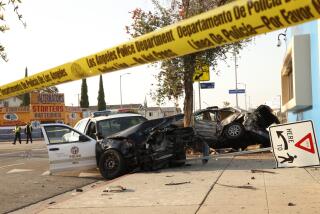Stolen Cars Cost Russian Owners Their Lives
- Share via
MOSCOW — Konstantin and Valeriya Khidrin decided in February to sell their 1994 Jeep Grand Cherokee. The Russian businessman and his wife, both 28, placed an advertisement in a popular publication, and they soon got a call from a man who wanted to buy the vehicle.
They went on a Monday to meet him at busy Taganskaya Square in central Moscow.
It was the last anyone saw of them until this week, when Moscow police dug up their bodies from beneath the concrete floor of a car repair shop eight miles from the Kremlin.
Police say the two were among 11 victims of an auto theft ring that lured car owners to the garage, murdered them and sold their vehicles.
The killers, who especially favored Jeep Grand Cherokees, selected their targets by reading the classified ads, police say.
Even by the standards of Moscow--where contract hits and gang killings have become commonplace--the depravity of the killings has stunned the public and police.
“These are people who have nothing human left in them whatsoever,” said Lt. Col. Igor Gubanov, head of the homicide division of the Moscow Criminal Investigations Department. “This is totally beyond my understanding. How can one kill people, including women, for just a piece of steel, bury the victims . . . and then invite the next victim over?”
The killings demonstrate how far Russia has come in the past seven years as the former Communist state has evolved into a quasi-capitalist country whose economy is dominated by organized crime and whose people are plagued by ordinary criminals.
The slain car owners appear to have been mainly New Russians, who had succeeded in amassing at least a small share of Russia’s wealth and enjoyed spending it on goods like foreign cars.
The 11 killings netted the thieves seven vehicles--three Jeep Grand Cherokees, a Mercedes, an Audi and two top-end Russian cars, police say. At most, police estimate, the thieves received $100,000 for them.
Police say they have rounded up all five members of the ring--which operated out of the repair shop in an industrial district on Moscow’s southeast side. Police are investigating whether there are more victims.
Soon after the Khidrins disappeared Feb. 9, the police began getting similar reports of people who vanished after setting off to sell their cars. The department formed a task force to investigate the disappearances and discovered two more that fit the pattern.
Based on interviews with relatives, police concluded that the criminals found their prey in the same daily advertising paper.
The thieves telephoned the sellers and arranged to meet at Taganskaya Square. After agreeing on a price, the “buyers” said they wanted to have a mechanic inspect the car. They arranged to meet the sellers the next day at the same square and drive to a repair shop they knew.
A relative who went with one male victim to meet the “buyer” stayed home the next day and lived to give police a detailed description of the suspect.
Police began checking auto shops in the area and zeroed in on Avtolux. There, an employee matched a police sketch based on the description.
About the same time, the police found a message on the answering machine of another missing car owner, asking him to call the Avtolux garage.
They raided the shop and found parts from a huge number of autos, as well as documents from some of the missing cars.
They also found a Russian-made Niva Taiga jeep that had been stolen in January from a man found bludgeoned to death in his own garage. Police now believe that he balked at going to the shop to see the “mechanic” and became the ring’s first victim.
During a second search of the shop, police discovered freshly laid asphalt under a pile of sand. They started digging and found clothes, passports, car papers and mobile phones belonging to some of the missing people. Farther down, they found five bodies.
Police also discovered a large floor drain that had been filled with cement. Underneath were five more bodies, including the Khidrins.
Moscow television news programs broadcast grisly footage of police exhuming the victims--the men who had been shot and Valeriya Khidrin, the only woman, who had been suffocated with a plastic bag.
More to Read
Sign up for Essential California
The most important California stories and recommendations in your inbox every morning.
You may occasionally receive promotional content from the Los Angeles Times.










